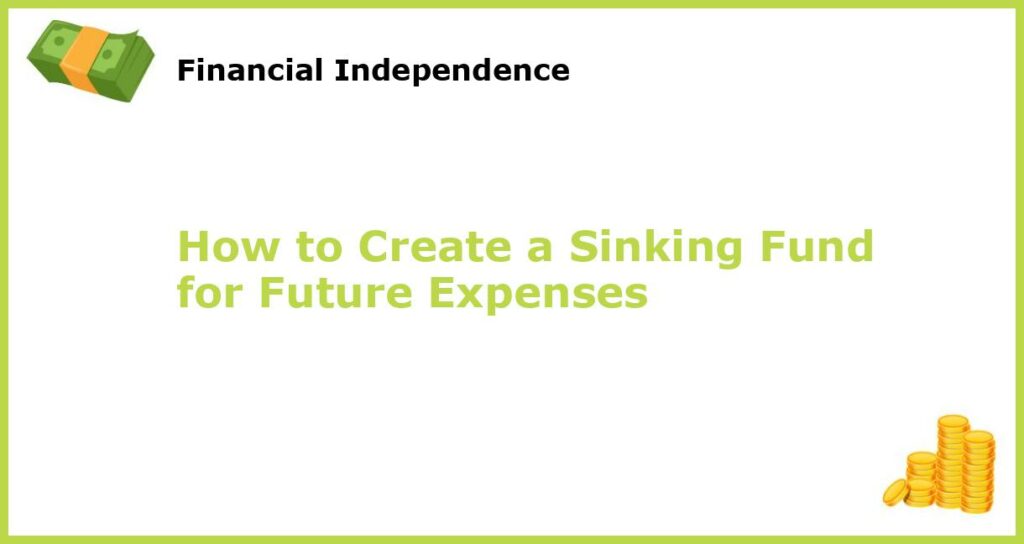Do you find yourself struggling to pay for expenses that are outside of your budget? Have you ever wished you had a savings account specifically set aside for those unexpected costs that always seem to pop up? If so, then a sinking fund may be the perfect solution for you. A sinking fund is a type of savings account specifically designed to help you plan for future expenses that are beyond your current budget. It’s a crucial part of any effective financial management plan, and in this article, we’ll discuss how you can create your own sinking fund.
Why You Need a Sinking Fund

Emergencies happen, and they usually come with unexpected expenses. One day, you may find yourself in a situation where you need to pay for a costly expense that you were not prepared for. A sinking fund allows you to plan ahead and prevent any financial difficulties that may arise out of emergency expenses. It enables you to achieve your financial goals while avoiding the stress of living paycheck to paycheck. Simply put, a sinking fund is a crucial tool you can use to manage your finances effectively.
Identify Future Expenses

Once you’ve decided to create a sinking fund, the first thing you need to do is to identify the expenses you need to save up for. Start by reviewing your budget to determine annual expenses like car insurance, professional certification fees, or tax payments. Determine the cost and the frequency of non-monthly or unexpected expenses such as appliance repair or replacement, health emergencies, or home maintenance. For recurring expenses, divide the total annual cost by 12 to help you set your monthly savings goals.
Set Your Savings Goals

After identifying the expenses you need to save up for, the next step is to set specific savings goals. Calculate how much you will need to save and determine how much time you will need to prepare adequately. Set a realistic goal for your savings each month or with each paycheck. Your actual savings goal will depend on the frequency of the expense, how much you need to save, and how much risk you are willing to take with your money. Make sure to set your goals with precision and make them achievable.
Choose the Right Savings Vehicle

Choosing the right savings account is vital when creating a sinking fund. You need an account that is safe, easy to access and provides some interest. You may consider options like a savings account, a money market account or a Certificate of Deposit (CD). An online savings account may be beneficial for earning high-interest rates and making deposits and withdrawals at any time of the day. A CD might be suitable for more significant expenses with longer-term investment plans. Whatever type of account you choose, make sure it’s one that meets your specific needs.
Make the Savings Automatic

The best way to ensure that you reach your savings goals is to automate your savings plan. You can do this by setting up recurring bank transfers and depositing the savings immediately after you receive your paycheck. By automating the transfers, you eliminate the possibility of forgetting to make the transfer or making late payments. You also build financial discipline by setting a routine for your finances.
Avoid Dipping into Your Sinking Fund

One of the hardest parts of saving money is having the discipline not to access the funds when they are not due. Using your sinking fund for purposes other than what you have planned for it may affect your ability to pay for the specific expense or financially destabilize your future expenses. If the expense you have been saving for has been deferred, you should continue saving towards it for it may come up in the future. Discipline is key when using a sinking fund.
Review and Adjust Regularly

Regularly reviewing your sinking fund goals is essential to determine if you are on track. You should adjust your goals regularly to reflect changes in your financial situation or upcoming expenses. As time passes by, it may become necessary to update the amounts set aside in your sinking fund accounts regularly. Don’t forget to factor in any interest earned on the accounts to see if you’re meeting your savings goals.
Utilize Sinking Fund Financing
If you can obtain financing at a lower interest rate than you can earn in a savings account, you may want to consider utilizing sinking fund financing. This means financing your future expense with a personal loan or using your savings account to pay for the expense now and pay the account back later with interest. However, it’s essential to weigh the differences in interest rates and carefully consider the financial impact of both options before making your final decision.
Celebrate Your Success
Creating a sinking fund requires discipline and effort. Setting and reaching your financial goals is an accomplishment in itself and is worthy of great acknowledgment. You should acknowledge yourself for your efforts and for the financial responsibility you showed throughout the process of creating a sinking fund. Celebrate your success by doing something fun and rewarding that aligns with your values and priorities.
Get Professional Help
It’s okay to ask for help when you need it. If you are finding it challenging to create a sinking fund or need advice on building a financial plan, consider hiring a financial planner. A financial planner can offer an objective and professional opinion to assess your current financial situation, identify future financial opportunities, and account for possible risks.







